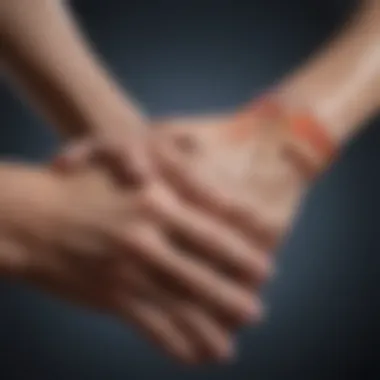Understanding Rheumatoid Arthritis Through Visual Representation


Intro
Rheumatoid arthritis (RA) remains a significant focus in medical research and practice. This chronic autoimmune disorder affects millions globally, resulting in joint pain, stiffness, and disability. Visual representation plays a vital role in understanding RA, helping to clarify the complexities of its symptoms and treatments. Images can serve as powerful tools not only for diagnosis but also for educating patients and professionals alike.
The intent of this exploration is to provide an overview of RA through visual means. By examining how images correlate with clinical stages, symptoms, and the efficacy of various treatments, a comprehensive narrative emerges. This narrative will enhance awareness and support better-informed decisions about managing this debilitating condition.
Article Overview
Summary of Key Findings
This article will highlight that visual representations are crucial in portraying the multifaceted nature of RA. Key findings include:
- Clinical Stages: Visual aids illustrate the progression of the disease, from early signs to advanced stages, thus helping to identify symptoms sooner.
- Symptoms and Treatments: Imagery depicting common symptoms provides clarity about the patient's experience, making it easier to understand treatment options.
- Imaging in Diagnosis: The significance of imaging technologies like X-rays, MRIs, and ultrasounds cannot be understated. These techniques not only confirm diagnoses but also track changes over time.
Research Objectives
The purpose of this article is twofold:
- To analyze the role of visual representation in understanding RA: This includes examining how images can convey essential information that might be overlooked in text alone.
- To elucidate the implications of findings: By recognizing the importance of imagery, we aspire to foster better communication among healthcare providers and patients, leading to improved treatment outcomes.
Preamble to Rheumatoid Arthritis
Rheumatoid arthritis (RA) is a significant autoimmune disorder that affects millions worldwide. Understanding its complex nature is crucial for both patients and healthcare professionals. In this section, we will delve into the definition, overview, epidemiology, and prevalence of rheumatoid arthritis.
Definition and Overview
Rheumatoid arthritis is a chronic condition characterized by inflammation in the joints, leading to pain, swelling, and eventually joint destruction. It primarily affects the lining of the joints, known as synovium, causing it to thicken and damage the cartilage and bone. RA can also affect other systems in the body, including the skin, eyes, lungs, heart, and blood vessels. Recognizing early symptoms is vital to managing this condition effectively. This understanding lays the foundation for proper diagnosis and treatment.
Epidemiology and Prevalence
The prevalence of rheumatoid arthritis varies globally. It impacts about 1% of the adult population. Factors such as age, gender, and genetic disposition contribute to the likelihood of developing this disease. Women are affected disproportionately, with a ratio of approximately 3:1 compared to men. The onset of symptoms often occurs between the ages of 30 and 60, although it can affect individuals at any age.
Understanding the epidemiology of rheumatoid arthritis helps identify at-risk populations, enabling targeted prevention strategies and efficient healthcare resource distribution.
In summary, this section underscores the importance of recognizing rheumatoid arthritis as a widespread condition with significant implications for public health. Proper knowledge of its definition and epidemiological characteristics can guide further exploration of its visual manifestations and clinical implications throughout this article.
Visual Symptoms of Rheumatoid Arthritis
Visual symptoms of rheumatoid arthritis play a crucial role in understanding the disease. These physical manifestations can serve as indicators of disease activity and progression. Such symptoms are not only critical for diagnosis but also for monitoring treatment efficacy. Visual cues allow patients and healthcare professionals to better grasp the state of the condition, fostering a more informed approach to care. Recognizing these signs is vital for timely interventions, ultimately improving patient quality of life.
Swelling and Inflammation
Swelling and inflammation are hallmark symptoms of rheumatoid arthritis. The body’s immune system mistakenly attacks the synovial membrane, leading to swelling in the joints. This inflammatory response often results in tenderness and warmth, making movement difficult.
Patients may experience notable swelling, especially in the hands and feet. Commonly affected joints include the wrists, knees, and fingers. This increased fluid around the joint can be discomforting and limits mobility. Recognizing these signs early may facilitate prompt treatment, potentially reducing long-term damage. Additionally, healthcare practitioners often assess the extent of swelling through physical examinations and imaging.
Joint Deformities
Joint deformities arise from the ongoing inflammation characteristic of rheumatoid arthritis. Over time, persistent swelling can lead to structural damage to the joints. Deformities often manifest as misalignment or instability. In severe cases, individuals may develop a visible change in joint shape, making everyday activities challenging.
Notable deformities include ulnar deviation of the fingers and swan-neck deformities of the hands. These changes not only affect physical function but may also have psychological impacts on patients due to altered appearance. Monitoring these deformities is essential. Images obtained through X-rays or MRI can track the progression and assist in determining appropriate therapeutic interventions.
Skin Changes
Skin manifestations are less commonly recognized but still significant in rheumatoid arthritis. Patients may develop nodules, commonly known as rheumatoid nodules, which are firm lumps occurring on pressure points, such as elbows and knuckles. These nodules can vary in size and may be painless.
In some cases, skin may appear red and inflamed due to indirect effects of joint inflammation. Rashes can also be present and may be associated with systemic symptoms. While skin changes may not directly affect joint function, they serve as a visual indicator of systemic involvement and disease severity. Understanding these symptoms helps both patients and caregivers to manage the condition more effectively.


Imaging Techniques in Rheumatoid Arthritis
Imaging techniques play a crucial role in understanding and managing rheumatoid arthritis. They provide valuable insights into the physical status of joints, helping in the diagnosis and treatment evaluation. These methods are not just about visual representation; they enhance clinical decision-making and patient education. The primary imaging techniques include X-rays, ultrasound, and MRI or CT scans. Each has its unique advantages and considerations. Knowing when and how to use these tools is essential for effective disease management.
X-rays
X-rays are often the first imaging technique used in assessing rheumatoid arthritis. They are readily available, cost-effective, and provide essential information about joint structure. X-rays can reveal typical changes such as joint space narrowing, erosions, and deformities. These signs are indicative of the disease's progression.
Benefits of X-rays include:
- Quick assessment of joint damage.
- Standardized technique for comparison over time.
- Wide availability across healthcare settings.
However, there are limitations. X-rays may not show early signs of inflammation or soft tissue changes. This means that, for some patients, X-rays might not be the only answer. Their role is often paired with more advanced imaging methods.
Ultrasound
Ultrasound provides a different perspective on joint changes. It allows for real-time visualization of soft tissues. This technique is useful for detecting inflammation that might not be visible on X-rays. It can identify synovitis, effusion, and tendon pathology, which are significant in rheumatoid arthritis.
Advantages of ultrasound include:
- Dynamic imaging, which allows for evaluation during movement.
- No radiation exposure, making it safer for repeated use.
- Cost-effective and highly accessible in many clinical settings.
However, like any technique, it has its limitations. The operator's skill greatly impacts ultrasound's effectiveness. Additionally, ultrasound may provide limited views of deeper joint structures compared to other imaging modalities.
MRI and CT Scans
MRI and CT scans are advanced imaging techniques that provide detailed images of joints and surrounding tissues. MRI is particularly useful in evaluating soft tissues, including ligaments, tendons, and cartilage. It can reveal early inflammatory changes in synovial tissue that are crucial for early diagnosis and treatment.
Key benefits of MRI and CT scans include:
- High resolution images that show minute anatomical details.
- Ability to detect early changes before significant bone destruction occurs.
- Comprehensive assessment that includes both hard and soft tissues.
However, these technologies are more expensive and less accessible than X-rays and ultrasound. They also require more time for the patient and technician. Furthermore, some patients may find it uncomfortable to remain still during the procedure.
"The application of imaging techniques in rheumatoid arthritis provides a foundation for effectively diagnosing and monitoring the disease, allowing for tailored treatment plans."
Images in Clinical Assessment
Images play a crucial role in the clinical assessment of rheumatoid arthritis. These visual representations not only help in diagnosing the disease but also aid in monitoring its progression and evaluating treatment efficacy. The use of images allows for a more nuanced understanding of the condition, providing insights that might not be apparent through physical examination alone.
Diagnosis of Rheumatoid Arthritis
Making an accurate diagnosis of rheumatoid arthritis is complex. It requires a thorough understanding of clinical symptoms and often benefits from imaging techniques. Images obtained from X-rays, ultrasound, or MRI can provide crucial information about joint damage, inflammation, and structural changes.
Key considerations in diagnosis:
- Identification of joint effusion: Seeing fluid around the joints on an ultrasound can indicate inflammation.
- Bone erosion: X-rays can reveal erosions that may suggest aggressive disease that can lead to permanent damage.
- Early detection: Advanced imaging techniques like MRI can identify early changes in synovial tissue and cartilage, which are critical for timely intervention.
“Visual aids in diagnosis not only clarify findings but also enhance clinician confidence in decision-making.”
Monitoring Disease Progression
Monitoring the progression of rheumatoid arthritis through imaging is vital for managing treatment plans effectively. Regular imaging helps track changes over time, which can inform therapeutic adjustments.
Benefits of monitoring images include:
- Tracking inflammation levels: Dynamic imaging techniques help visualize active inflammation or new lesions.
- Assessing joint health: By comparing images over time, one can better understand the impact of the disease on musculoskeletal structures.
- Guiding treatment plans: Data derived from imaging results can inform rheumatologists on whether to escalate or modify treatment based on the observable progression.


Evaluating Treatment Efficacy
Images are essential for assessing how well a treatment is working. They provide objective evidence on whether a patient's condition improves, worsens, or stabilizes in response to therapy.
Important aspects to evaluate effectiveness include:
- Reduction in inflammation: Changes in imaging findings can indicate a successful response to therapy, such as decreased synovial thickening visible in ultrasound scans.
- Prevention of structural damage: Regular imaging can show if joint structures are maintaining their integrity, signaling effective disease control.
- Patient-reported outcomes: Linking imaging results with patient reports on pain and function creates a holistic view of treatment success.
Impact of Visual Aids in Patient Education
Visual aids play a crucial role in educating patients about rheumatoid arthritis. They help bridge the gap between complex medical terminology and patient understanding. Through clear images and diagrams, individuals with this condition can grasp the nuances of their diagnosis, treatment options, and ongoing management strategies. This understanding fosters an informed decision-making process.
Understanding the Condition
Patients often face challenges in comprehending their health status after a rheumatoid arthritis diagnosis. Visual aids, such as charts and infographics, can simplify this complexity. For example, a diagram showing the difference between healthy joints and those affected by rheumatoid arthritis can illustrate inflammation, joint destruction, and deformities. This could prompt questions and discussions between patients and healthcare providers, enhancing the educational experience.
- Benefits of Visual Aids:
- Clarity in representation of symptoms and conditions.
- Enhanced retention of information through visual memory.
- Greater engagement in discussions regarding treatment options.
Patients can visualize their symptoms and understand what to expect during flare-ups or remission. Furthermore, educational videos that depict exercises beneficial for joint mobility provide practical knowledge. This visual exposure equips patients with tools to better manage their health on a day-to-day basis.
Encouraging Treatment Adherence
Adhering to treatment regimens is central to managing rheumatoid arthritis. Visual aids can encourage adherence by making the treatment process more relatable and comprehensible. Infographics depicting a treatment timeline can help patients see how their medications or therapies will benefit them over time. Moreover, patients may appreciate images showcasing the potential health improvements achieved through consistent treatment.
- Key Considerations:
- Presenting treatment pathways visually promotes understanding.
- Simplifying complex drug regimens reinforces patient knowledge.
- Visual success stories can motivate continued adherence to treatment.
Such representations can also highlight the importance of follow-up visits, emphasizing how these contribute to their long-term health. In addition, integrating patient testimonials with a strong visual component can create a sense of community and support. In this shared experience, new patients see themselves in others’ journeys, fostering a stronger commitment to their own treatment plans.
"Visual aids not only inform but also empower patients, transforming them from passive recipients into active participants in their care."
In summary, using visual aids enhances patient education by demystifying the complexities of rheumatoid arthritis. This approach encourages understanding and promotes adherence to necessary treatments. Such strategies ultimately lead to better health outcomes and improved quality of life for individuals battling this chronic condition.
Rheumatoid Arthritis Imagery in Clinical Research
Rheumatoid Arthritis (RA) imagery plays a crucial role in clinical research, offering insights that are essential for understanding the complexities of this autoimmune disease. Visual representations such as imaging techniques and photographic documentation enhance the understanding of RA's progression and response to therapies. This visual approach assists researchers and clinicians in examining disease mechanisms, outcomes, and improvements over time. The effective use of imagery can facilitate more precise diagnoses and enhance treatment strategies.
Role in Clinical Trials
In clinical trials for rheumatoid arthritis, imagery is indispensable for several reasons. Firstly, it allows researchers to track changes in joint structure and inflammation. Techniques such as MRI and ultrasound provide detailed images that reveal the extent of damage or response to treatment. When clinical assessments are combined with imaging, the reliability of trial results improves significantly.
Moreover, imagery can serve as an endpoint in clinical trials. It allows for objective measurements of disease activity and structural changes. This objectivity can drive more accurate evaluations of a drug's efficacy. For example, a trial studying the effects of a new biologic, like Adalimumab, may utilize MRI findings to assess synovial inflammation and joint erosion in patients over time. These measurable outcomes help in drawing informed conclusions regarding treatment effectiveness.
Contributions to Scientific Literature
Rheumatoid arthritis imagery contributes extensively to the scientific literature, enriching understanding and broadening research avenues. The integration of imaging findings in publications enhances the credibility and depth of studies. As RA continues to be a significant health concern, new images and data aid in documenting longitudinal changes in patient health.
This body of work advances the knowledge on RA, offering insights such as:
- Pathophysiological Insights: Imaging reveals how the disease develops over time, allowing for exploration of its mechanisms.
- Disease Monitoring: Visual representation helps in establishing standard protocols for monitoring disease progression and treatment response.
- Targeted Research: By documenting cases with specific characteristics, researchers can identify patterns or repertoires of RA responses.
More than just aesthetic findings, these contributions build a framework for ongoing research and future studies, guiding further investigations into novel treatment options, better diagnostic measures, and improved patient outcomes.
Gallery of Rheumatoid Arthritis Images


In the exploration of rheumatoid arthritis, images can provide powerful insights. A gallery of Visual representations offers not just a glimpse into the condition but also a deeper understanding of its clinical implications. It serves as a key resource for various stakeholders like medical practitioners, researchers, and patients.
Importance of Visual Representation
Images capture the complexities of rheumatoid arthritis that text alone may fail to convey. By viewing conditions in various stages, one can appreciate different symptoms and the effectiveness of treatments. This has several benefits:
- Facilitating Diagnosis: Representative images assist medical professionals in recognizing the specific signs of rheumatoid arthritis. They can compare a patient’s condition to established visual criteria, enhancing diagnostic accuracy.
- Enhancing Patient Education: Patients can better grasp their condition through images. Understanding what to expect helps alleviate anxiety and fosters compliance with treatment regimens.
- Documenting Progression: Photographic evidence can crucially document the physical changes over time, enabling both patients and doctors to visualize disease progression.
Representative Images for Diagnosis
Representative images play a significant role in the diagnostic process. They include various photographs or scans depicting:
- Joint Swelling: Images showcasing joint areas affected by swelling enable learners to identify early signs of rheumatoid arthritis.
- Deformities: Photographs of hand and foot deformities can be instructive, highlighting how severe cases might appear. Understanding these deformities can lead to earlier intervention.
- Inflammatory Markers: Imaging can reveal specific markers of inflammation, making it more apparent for practitioners to assess disease activity.
Moreover, integrating these images into training programs for health professionals can streamline their learning process.
Photographic Documentation of Progression
Tracking the evolution of rheumatoid arthritis through photographic documentation is crucial for both clinical assessment and research.
- Baseline Comparisons: Initial images provide a baseline for evaluating treatment effectiveness and disease progression.
- Continuity in Care: Regular photographic documentation allows for a continuous review of the disease's impact on the patient’s life. This can inform treatment adjustments, leading to better health outcomes.
- Research Applications: In research, these images can be utilized to study patterns of disease progression among different populations, contributing to the scientific literature on the subject.
Overall, a gallery of images related to rheumatoid arthritis enriches the understanding of this complex condition. By allowing for visual acknowledgment of how rheumatoid arthritis manifests, it breaks down barriers to understanding, ultimately leading to better care and support for those affected.
Future Directions in Rheumatoid Arthritis Imaging
Rheumatoid arthritis (RA) continues to challenge both researchers and clinicians due to its complex nature and unpredictable course. As we delve into future directions in imaging for rheumatoid arthritis, it becomes clear that advancements in this field are crucial for enhancing patient outcomes. Improved imaging techniques promise to yield better diagnostic accuracy and provide deeper insights into disease progression. By harnessing technological innovations and integrating them into routine practice, healthcare providers can facilitate more personalized and effective treatment strategies for patients.
Advancements in Technology
Recent years have seen significant advancements in imaging technologies that expand options for rheumatoid arthritis evaluation. Innovations such as high-resolution ultrasound and advanced MRI techniques like diffusion-weighted imaging are particularly noteworthy. These technologies allow for a more detailed visualization of joint structures and pathology, which can lead to earlier detection of disease activity.
- High-Resolution Ultrasound: This approach enhances the ability to detect synovitis and tenosynovitis, detecting subtle changes that may go unnoticed with conventional imaging methods.
- Advanced MRI Techniques: Newer protocols enable the assessment of joint inflammation and damage with greater precision, aiding clinicians in distinguishing between active inflammatory processes and chronic joint destruction.
These advancements illustrate a commitment to a more nuanced understanding of rheumatoid arthritis, ensuring that imaging plays an active role in both diagnosis and ongoing management.
Integrative Approaches to Imaging and Therapy
The future of rheumatoid arthritis imaging is not solely about technological advancements; it also leans towards an integrative approach that combines imaging data with therapeutic interventions. This aspect is vital in confirming treatment efficacy and modifying therapies based on real-time imaging feedback. As we seek more holistic management strategies, it is essential to consider how imaging can guide therapeutic decisions.
Integrating imaging findings with clinical assessments and treatment plans may greatly improve patient-centered care in rheumatoid arthritis.
- Multimodal Imaging: Combining ultrasound, MRI, and other imaging findings gives a comprehensive view. This aids clinicians in making informed treatment decisions and adjustments.
- Collaboration between Disciplines: Bridging rheumatology, radiology, and patient care is necessary to foster better communication and streamline processes in managing rheumatoid arthritis.
In summary, the future directions in rheumatoid arthritis imaging highlight a multifaceted approach. Continued advancements in technology, alongside integrative methods that connect imaging with therapeutic actions, set the stage for a more precise and effective management of this chronic condition.
Ending
The conclusion serves a crucial role in synthesizing the extensive information presented throughout this article on rheumatoid arthritis and its visual representation. In summary, the multifaceted relationship between visual aids and the understanding of this complex autoimmune disorder cannot be overstated. As highlighted, images are not just supplementary; they are fundamental in clinical assessment, patient education, and ongoing research.
Summary of Key Points
- Visual Symptoms: The various symptoms of rheumatoid arthritis, including swelling, joint deformities, and skin changes, were discussed to provide insight into how these physical manifestations influence diagnosis and treatment.
- Imaging Techniques: Different imaging modalities such as X-rays, ultrasound, and MRI/CT scans were examined, demonstrating their significance in capturing the disease's progression.
- Clinical Assessment: Images are essential in diagnosing rheumatoid arthritis and monitoring its advancement, helping medical professionals make informed treatment decisions.
- Patient Education: Visual aids enhance patient understanding of their condition, encouraging adherence to treatment regimens.
- Impacts on Research: The discussion on how imagery contributes to clinical trials and scientific literature illustrates the value of visual data in advancing knowledge.
Implications for Future Research
The treatment and understanding of rheumatoid arthritis can significantly benefit from ongoing research effort. New imaging techniques, for example, may emerge that provide more detailed insights into the disease, leading to earlier diagnosis and more personalized treatment plans. Importantly, understanding the psychological effects of these visual representations on patients could lead to better patient engagement strategies.
The integration of artificial intelligence in analyzing imaging data also offers a promising frontier, allowing for quicker and more accurate readings. As medical professionals and researchers continue to explore these avenues, it is vital that we prioritize funding and resources to support inclusive and comprehensive studies.
"Innovative imaging techniques can change the landscape of how chronic conditions like rheumatoid arthritis are understood and treated."
In summary, this article underscores the critical importance of visual representation in understanding rheumatoid arthritis. As we advance towards a future filled with research possibilities, the implications for patients and healthcare providers alike are profound.







